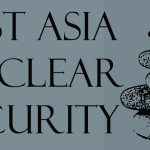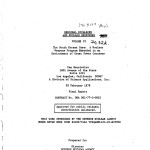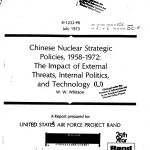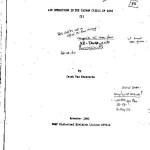Shen Dingli, Professor and Executive Dean at Fudan University, writes that the new leadership in Pyongyang has to continue to strengthen Kim Jong-un’s power base, which doesn’t allow it to be either too hostile or receptive to the outside world. It also has to be politically correct and follow Kim Jong-il and Kim Il-sung’s Juche ideology, demonstrating self-reliance. Therefore, to quit the nuclear weapons program is a non-starter. While the DPRK has signaled its intent to return to the Six-Party Talks, this is, in Shen Dingli’s opinion, a tactical move, not a strategic commitment to denuclearization. “All parties involved in the talks should combine their legitimate needs with a realistic approach … Unless other parties would relinquish their nuclear weapons or the benefit of a nuclear umbrella, demanding Pyongyang to rid its nuclear program without prior trust-building is wishful thinking.” In the meantime, in order to manage its shortage of resources, the DPRK has to keep bargaining with others and develop its economy—and this could bode well for engagement and stability.
Archives
NAPSNet 2 February 2012
- DETERRENCE: Nuclear and conventional extended deterrence in a Northeast Asian nuclear weapons-free zone, summary report
- DPRK: China urges international help for N. Korea
- CLIMATE CHANGE ADAPTATION: A meta-analysis of global urban land expansion
- ENERGY SECURITY: This week in clean economy: Renewables industry, advocates weigh in on Obama plan
- GOVERNANCE AND CIVIL SOCIETY: North Korea topic of South Korea, Japan, US defense-level talks
Nuclear and Conventional Extended Deterrence in a Northeast Asian Nuclear Weapons-Free Zone – Summary Report of the East Asia Nuclear Security Workshop

This summary report is based on the proceedings and presentations given at the East Asia Nuclear Security workshop held on November 11, 2011 in Tokyo, Japan. The workshop aimed to evaluate the robustness of proposals to establish a nuclear weapons-free zone in Northeast Asia (NEA-NWFZ) and to identify pathways leading to its creation. The workshop was organized by the Nautilus Institute, the Maureen and Mike Mansfield Foundation and Nautilus Australia – RMIT Global Studies, and co-hosted by the Asia Pacific Leadership Network.
Papers and presentations given at the East Asia Nuclear Workshop are available here, along with the full agenda, participant list and a workshop photo gallery.
Policy Forum 12-03: The Post Kim Jong-il Era and the 2013 Regime in South Korea
Nak-chung Paik, Editor of The Quarterly Changbi and Professor Emeritus of English Literature at Seoul National University, asks “Which will be the greater variable, the leadership change in North Korea or the 2013 regime change in South Korea?” Paik asserts that since the North Korean succession does not show signs of sparking an imminent political or social upheaval, South Korea, with upcoming elections, has the opportunity to engage North Korea, establish a peace agreement and perhaps eventually an inter-Korean confederation. The key, Paik writes, is the 2013 South Korean regime: “Will we content ourselves with the same old ruling forces who have changed face and succeeded in “differentiation from Lee Myung-bak,” or will we make the historic transition to a new epoch not only in the South but possibly shared by South and North?”
NAPSNet 26 January 2012
- DETERRENCE: Missile defense intercepts in space: A problem not solved
- DPRK: Lee Myung Bak regime accused of disturbing peace and security in northeast Asia
- CLIMATE CHANGE ADAPTATION: Adapting for a green economy: Companies, communities and climate
- ENERGY SECURITY: Post-crisis Japanese nuclear policy: From top-down directives to bottom-up activism
- GOVERNANCE AND CIVIL SOCIETY: Yokohama Declaration for a Nuclear Power Free World
REGIONAL RIVALRIES AND NUCLEAR RESPONSES – Volume II – The South Korean Case: A Nuclear Weapons Program Embedded in an Environment of Great Power Concerns

This 1978 report by Bryan Jack is the second volume of a three part report that considers the possible role of nuclear weapons that might be possessed by new nuclear powers in three key regions-the Arabian Sea, Northeast Asia and the South China Sea. This volume focuses on China, Korea and Japan and the particular circumstances facing each country, including: what might influence the decision to acquire nuclear weapons, the kind of weapons systems that might be acquired, possible types of weapons deployment both for deterrence or actual use, the impact on regional security of weapons acquisition and the policies that might be adopted by states in the region and by the United States to deter acquisition or to mitigate the consequences if acquired.
This report was released to the Nautilus Institute under the US Freedom of Information Act (FOIA). See the Institute’s FOIA Global Disclosure Project page to read more chronologies, histories and reports released to Nautilus.
Policy Forum 12-02: North Korea’s Transition: Do Not Let Contingencies Distract from Realities
John Delury, Assistant Professor of East Asian Studies at Yonsei University and Chung-in Moon, Professor of Political Science at Yonsei University state that a near-term crisis in North Korea is unlikely for the simple reason that the country’s political system is unified around the new face of North Korea, Kim Jong-un. However, in the medium to longer term, the new leadership is likely to face a dilemma: whether Kim Jong-un can enhance North Korea’s prosperity without undermining the source of its strength — its nuclear weapons program. Delury and Moon argue that “[t]he most prudent course for key regional players is to re-open or expand channels with Pyongyang. The better we know the new leadership, the better we can respond to events as they unfold.”
NAPSNet 19 January 2012
- DETERRENCE: Military aspects of a study of the implications of a communist Chinese nuclear capability
- DPRK: Kim Jong Un focuses on economic reforms, N. Korea official says
- CLIMATE CHANGE ADAPTATION: Catalyzing urban climate resilience: Applying resilience concepts to planning practice in the ACCCRN Program…
- ENERGY SECURITY: Simultaneously mitigating near-term climate change and improving human health and food security
- GOVERNANCE AND CIVIL SOCIETY: Washington, Beijing’s relief over Taiwan election will be temporary
Chinese Nuclear Strategic Policies, 1958-1972: The Impact of External Threats, International Politics, and Technology

This 1973 report by W.W. Whiston is the first of a two-part analysis of Chinese nuclear policy and weapons options carried out as a part of the U.S. Air Force Project RAND’s studies of the implications of Soviet and Chinese military policy and strategy for Air Force planning. It examines (1) internal political and ideological conflict, (2) alternative military strategies for coping with external versus internal threats, and (3) nuclear technological capabilities from 1958 to 1972. Whiston examines how the Mao-Liu divide impacted the military structure and organization and the newborn nuclear weapons program in the 1960s.
This report was released to the Nautilus Institute under the US Freedom of Information Act (FOIA). See the Institute’s FOIA Global Disclosure Project page to read more chronologies, histories and reports released to Nautilus.
Air Operations in the Taiwan Crisis of 1958

This report is one of a series of studies on air operations in international incidents, prepared by the USAF Historical Division Liaison Office at the request of the Directorate of Plans, Headquarters USAF. This historical narrative, by Jacob Van Staaveren, is based on primary source materials available in 1960–messages and correspondence–and on histories from many levels of the Air Force, including units, commands, and the Air Staff. As Staaveren’s report demonstrates, the crisis in 1958 provided a test of American military planning concepts. Occurring in the Pacific almost simultaneously with the Lebanon crisis of July-August 1958, it created certain planning, operational and logistical problems that had not been anticipated.
This report was released to the Nautilus Institute under the US Freedom of Information Act (FOIA). See the Institute’s FOIA Global Disclosure Project page to read more chronologies, histories and reports released to Nautilus.

